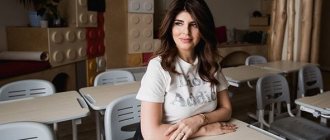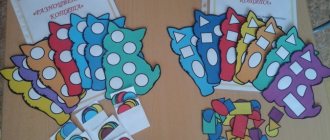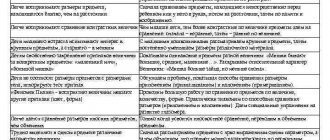Pedagogical Council "Modern pedagogical technologies in preschool institutions"
Currently, teaching staff of preschool educational institutions are intensively introducing innovative technologies into their work. Therefore, the main task of preschool teachers is to choose methods and forms of organizing work with children, innovative pedagogical technologies that optimally correspond to the goal of personal development. Many technologies have quite a lot of similarities in their goals, content, methods and means used, and based on these common features they can solve the problem of forming a “competent personality” in accordance with the targets outlined in the Standard.
A fundamentally important aspect in pedagogical technology is the child’s position in the educational process, the attitude of adults towards the child. When communicating with children, an adult adheres to the position: “Not next to him, not above him, but together!” Its goal is to promote the development of the child as an individual.
Today we will talk about educational technologies and their effective use in preschool institutions.
You and I will be builders and we will build a house under the name, and we will give the name of the house when we resolve all the issues of our council.
To begin construction, the site must be cleared. The letters were scattered on it; they had to be assembled into a word.
This word includes methods, techniques, a sequence of operations and procedures; it is closely related to the means, equipment, materials used, or it is clear and unambiguous knowledge (usually in the form of a set of rules or an algorithm) that allows one to obtain the desired final result from the initial components ( technology).
Game "Collect the word."
The site for the construction of a house consists of the main word - technology. The foundation of our house will begin to build and consolidate our knowledge about modern educational technologies in a preschool educational organization, the senior teacher of the preschool educational institution “Modern educational technologies in the context of the Federal State Educational Standard.”
Let's review what the term “technology” itself means.
Technology
comes from the Greek words for "skill, art" and "law, science" - this is
the science of craftsmanship.
The core of any technology: goal - means - rules for their use - result.
Pedagogical t
technology functions both as a science that studies and designs the most rational way of learning, and as a system of algorithms, methods and results of activities, and as a real process of teaching and education.
Pedagogical technology
is a holistic, scientifically based project of a certain pedagogical system from its theoretical concept to implementation in educational practice, reflecting the procedural side of training and education and covering their goals and content. Forms, methods, means, results and conditions of their organization.
Creativity of preschool children and modern educational technologies
Target. Strengthen the professional knowledge of teachers in the field of modern educational technologies.
Progress of the pedagogical council
Presenter . I welcome you to the next council of teachers.
Manager. Implementation of the decision of the previous council of teachers.
Psychological warm-up from an educational psychologist
Presenter . Today you and I will be builders and we will build a house with a name, and we will give the name of the house when we resolve all the issues of our council.
Presenter . To begin construction, the site must be cleared. The letters were scattered on it; they had to be collected into words. Game "Collect the word."
| E | WITH | ABOUT | IN | T | T |
| H | T | IN | R | P | E |
| R | WITH | ABOUT | ABOUT | N | X |
| ABOUT | IN | TO | E | ABOUT | I |
| TO | T | T | U | L | AND |
| M | A | b | B | ABOUT | G |
Clue.
- This word means self-expression and self-affirmation of a child, his individuality (creativity) is clearly revealed, or this is the process of human interaction with the surrounding reality, this can and should be taught, it is not an innate quality of personality and develops gradually under the influence of upbringing and training.
- This word includes methods, techniques, a sequence of operations and procedures, it is closely related to the means, equipment, materials used (technology) or it is clear and unambiguous knowledge (usually in the form of a set of rules or an algorithm) that allows you to obtain the desired from the initial components final result.
- This word means a plan, idea, image, embodied in the form of description, justification, calculations, drawings that reveal the essence of the plan and the possibility of its practical implementation (project)
Presenter . The site for building a house consists of basic words - creativity, technology, project. The foundation of our house will begin to be built and consolidate our knowledge about modern educational technologies in a preschool educational organization by the head of the preschool educational institution “Modern educational technologies in the context of the Federal State Educational Standard.”
(Speaker is the head of a preschool educational institution.)
Presenter . Let's start the construction of the first floor with our existing theoretical and practical knowledge, skills and abilities in the development of creativity in preschool children.
Speaker senior teacher “Results of the thematic audit “Organization of the educational environment of kindergarten groups in the development of children’s creativity”
Relaxation from the speech therapist teacher - games to develop children's speech creativity.
Presenter . We will build the second floor on the experience of teachers in using modern educational technologies in their work.
Speakers:
teacher of the secondary group “Project activities in the development of creative abilities in preschool children”;
teacher of the school preparatory group “Use of TRIZ technology techniques in the development of creative abilities in preschool children.”
Relaxation from the music director - games to develop children's musical creativity.
Presenter . We are moving on to the construction of the third floor, it is based on the creative abilities of our students. Additional education in a preschool organization is the created pedagogical conditions for the development of the child’s creative personality. We have organized artistic and aesthetic circles, and the leaders of the circles will talk about the creative skills of preschoolers:
- Teacher of the preparatory school group “Report on the work of the Lyap-Lepych circle.”
- Teacher of the senior group “Report on the work of the Rosinka circle.”
Presenter . The construction of the third floor – the last – has been completed. We need to build a roof. We will build a roof using the game syncwine.
Cinquain is a French word that means “poem of five lines.” The cinquain form was developed by the American poet Adelaide Crapsey, who relied on Japanese poetry - hoku (haiku). This is a small verse, consisting of three lines without rhyme, a lyric poem characterized by brevity, which is read very slowly.
Cinquain is an unrhymed poem, which today is a pedagogical technique aimed at solving a specific problem.
Relatively recently, teachers began to use syncwine to enhance cognitive activity and began to use it as a method of speech development.
To compose a syncwine, you need to learn to find the main elements in the text, in the material, draw conclusions and conclusions, express your opinion, analyze, generalize, isolate, combine and briefly present.
We can say that this is a flight of thought, free mini-creativity, subject to certain rules.
Rules for compiling syncwine:
- The first line of a syncwine is a title, a topic, consisting of one word (usually a noun meaning the object or action in question).
- The second line is two words. Adjectives. This is a description of the characteristics of an object or its properties, revealing the theme of syncwine.
- The third line usually consists of three verbs or gerunds describing the actions of the subject.
- The fourth line is a phrase or sentence consisting of several words that reflect the personal attitude of the author of the syncwine to what is said in the text.
- The fifth line is the last. One word is a noun to express one’s feelings, associations associated with the subject discussed in the syncwine, that is, it is the author’s personal expression on the topic or a repetition of the essence, a synonym.
It is assumed that with preschool children, strict adherence to the rules for compiling syncwine is not necessary.
Leading. The 1st group of teachers composes the word “PROJECT”, the 2nd group – the word “TECHNOLOGY” and the 3rd group – the word “CREATIVITY”.
Leading. We built the house and what suggestions do you have for the name of our house?
The teachers come up with a name for the house.
A draft decision of the pedagogical council is submitted.
Innovative activity as a condition for the formation of professional competence of preschool teachers
Innovative activity as a condition for the formation of professional competence of preschool teachers
The transformation of preschool education into preschool education has made it an integral and full-fledged stage of the educational system as a whole, as defined by the Law “On Education”.
The changing role of education provoked the development of the innovation process. Until now, the focus of education has been the development of knowledge, skills and abilities. Now education is focused on the development of technologies and methods of influencing the individual. The main figure in the innovation process is the teacher, who is able to change and rebuild his activities in accordance with the needs and capabilities of the child and his own development resources. To do this, the teacher must be fluent in the concepts of “innovation”, “newness”, “innovation”, “pedagogical innovation”.
The concept of “innovation” translated from Latin means “renewal, innovation or change.” This concept first appeared in research in the 19th century and meant the introduction of certain elements of one culture into another. At the beginning of the 20th century, a new field of knowledge arose, innovation - the science of innovation.
In relation to the pedagogical process, innovation means the introduction of new things into the goals, content, methods and forms of training and education, the organization of joint activities of the teacher and students. Thus, pedagogical innovation is an intentional qualitative or quantitative change in teaching practice and improving the quality of the educational process.
The combination of motivational (I want), theoretical (I can), technological (I do) and effective (I receive) readiness constitutes a system of innovative competence of a preschool teacher.
It is necessary to distinguish between the concepts of “novation” and “innovation”.
Innovation is precisely a means (a new method, technique, technology, program, etc.), and innovation is the process of mastering this means.
Innovative activities in preschool educational institutions can proceed in two directions:
1. Innovations in working with teaching staff 2. innovations in the content of education
Among the technologies that represent innovation in education, the following examples can be given:
Innovative forms of working with children:
-project activities;
-personally-oriented learning (involves creating conditions for the formation of a preschooler’s individuality - to implement this approach, they create corners for activities and games, sensory rooms);
- health-saving technologies (to improve the health of preschool children through the introduction of breathing, orthopedic gymnastics, stretching, hardening, hatha yoga);
-research activities;
- information and communication training;
-game technique
-correctional technologies (to relieve psycho-emotional stress of preschoolers - color, fairy tale, art therapy).
Innovative forms of interaction with parents:
Group forms of work include a system of parent meetings in a non-standard form (discussion, open day, master class, etc.) and mass events (mini-trip, competitive entertainment programs, etc.), containing based on leisure and intellectual-cognitive activities. All this contributes not only to increasing the psychological and pedagogical competence of parents, but also to the formation of their communicative culture in the process of communicating with teachers and children.
The visual and information area includes: - parent corners, - family and group albums; - library - moving, - photomontages; — photo exhibitions; - family vernissage; etc.
Innovations in working with teaching staff:
This ensures the active participation of preschool teachers in methodological work, which, in turn, contributes to improving the system of continuous education and self-education of preschool teachers:
— Workshops — creative classes aimed at developing creative thinking and creating innovative projects. — Press conferences help to quickly find information on individual problems, deeply comprehend it, and discuss individual issues with colleagues. — Game modeling. — Business and role-playing games — involve modeling a real process, during which optimal professional decisions are made based on the analysis of artificially created pedagogical situations. A business game as a teaching method allows you to “live” a particular practical situation. — Trainings to improve professional skills.
An effective form is to hold an exhibition - a fair of pedagogical ideas, an auction. Properly prepared and carried out, it stimulates teachers to creativity and self-education. Therefore, the main result of the exhibition-fair is a noticeable professional and personal growth of educators. Thanks to this form of work with teachers, conditions are created for the public presentation of the best examples of their professional activities, the emergence of new ideas, and the establishment and expansion of business and creative contacts with colleagues.
That. the use of innovative pedagogical technologies contributes to: improving the quality of education; advanced training for teachers; the use of pedagogical experience and its systematization; improving the quality of training and education. Taken together, this will lead to an increase in the level of educational work of preschool educational institutions and will unite the team of teachers.
2




